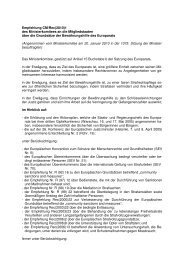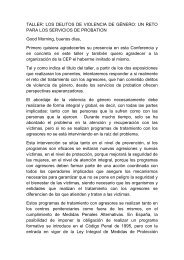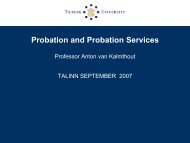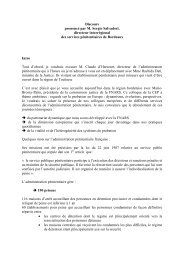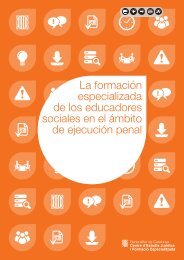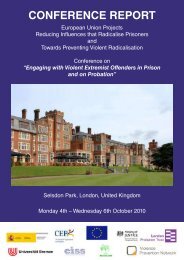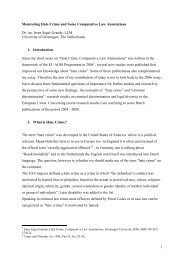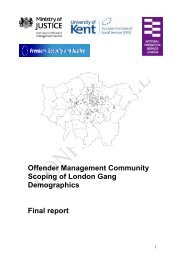Chapter 2 Austria - CEP, the European Organisation for Probation
Chapter 2 Austria - CEP, the European Organisation for Probation
Chapter 2 Austria - CEP, the European Organisation for Probation
Create successful ePaper yourself
Turn your PDF publications into a flip-book with our unique Google optimized e-Paper software.
feedback report to <strong>the</strong> public prosecutor or to <strong>the</strong> judge, 2whe<strong>the</strong>r mediation has been successful or notdismissal of proceedings in case continuation of proceedings in caseof a positive reportof a negative report4.2.1.1 Objectives of ATA- <strong>the</strong> victim has <strong>the</strong> possibility to receive restitution, both emotional andmaterial;- needs and emotions of <strong>the</strong> victim are taken seriously;- <strong>the</strong> suspect is given an opportunity to consider how to make good <strong>the</strong> offence.The suspect is not in a defensive position as during a trial but can take anactive role to repair <strong>the</strong> harm caused;- <strong>the</strong> dismissal of proceedings after a positive report avoids a criminal recordwith its possible negative consequences (job-seeking in a crowded labourmarket);- a viable agreement negotiated by <strong>the</strong> suspect and <strong>the</strong> victim offers <strong>the</strong> chance<strong>for</strong> durable social peace (55% of allocated cases originate in <strong>the</strong> immediatesocial environment).4.2.1.2 Types of offences and conflicts84% of all referred cases are offences related to aggression (Aggressionsdelikte),in particular assault and battery (Körperverletzungen), o<strong>the</strong>rs include seriousthreats (gefährliche Drohungen), coercion, harassment (Nötigungen) and insome cases robbery (Raub). The remaining 16% comprise mainly propertyoffences (Vermögensdelikte), i.e. <strong>the</strong>ft, burglary, vandalism. With regard toconflict types and environments particularly important <strong>for</strong> mediators handlingcases, 55% concern <strong>the</strong> immediate social environment, i.e. partnerships (mainlyviolent offences), family and friends, work place, school, as well as <strong>the</strong> mostdifficult type of conflict to mediate, conflicts among neighbours. As <strong>the</strong> clientshave known each o<strong>the</strong>r be<strong>for</strong>e <strong>the</strong> offence was committed and will in most casesremain in contact in <strong>the</strong> future it is of particular importance to work out aperspective of what future contacts could be like.4.2.1.3 Organization and methodsMediation is organised as a specially defined field of practice. This means thatwithout exception only specialised and trained mediators carry out mediation inpenal cases. There are no social workers in <strong>Austria</strong> who work concurrently asprobation workers and as mediators. Depending on <strong>the</strong> type of conflict differentmethods may be employed. One or two mediators may work on individual cases.A female and a male mediator, <strong>for</strong> instance, will handle cases of domestic2In 90% of <strong>the</strong> cases, referral is done by <strong>the</strong> public prosecutor. In 10% of <strong>the</strong> cases <strong>the</strong> ordercomes from a judge.


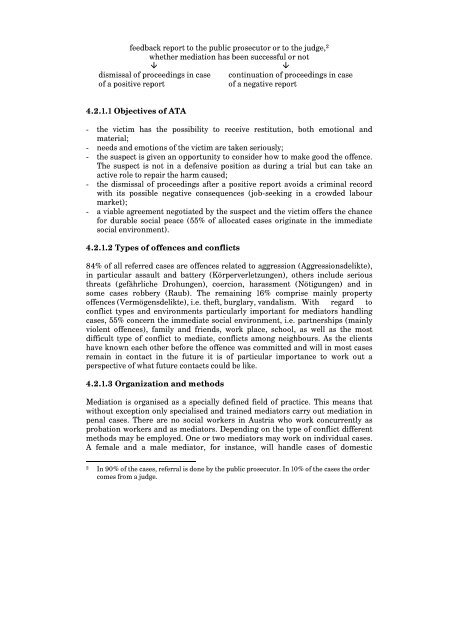

![AGIS2 Nov 08 Conference Report_[Version 2] - CEP, the European ...](https://img.yumpu.com/50764570/1/190x245/agis2-nov-08-conference-report-version-2-cep-the-european-.jpg?quality=85)
